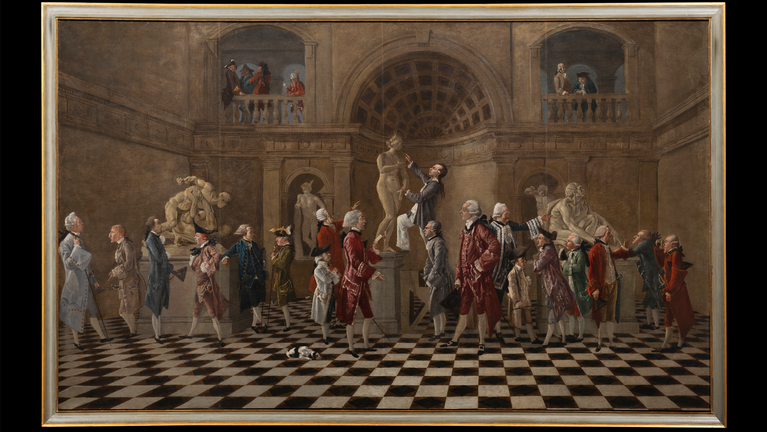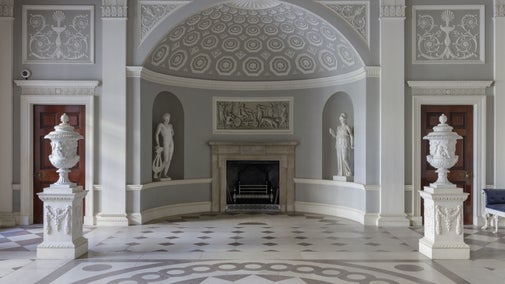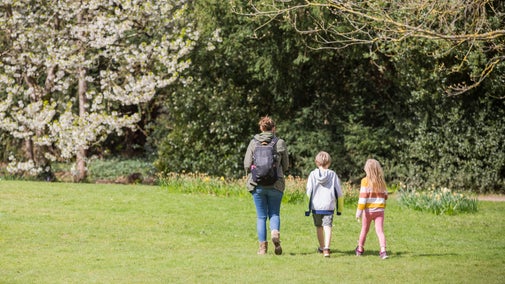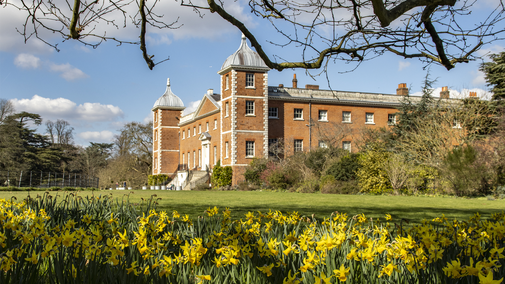A Grand Tour: Discover Italy in Isleworth
- Published:
- 03 July 2024

From Italy to Isleworth, the Ford Collection joins Osterley as a permanent art display. Discover Grand Tourists and artists associated with the Grand Tour, including works from the architect Robert Adam who designed Osterley Park and House in the late 18th century.
A new home at Osterley
The Ford Collection was gifted to the National Trust in 2023 by Augustine Ford, Brinsley Ford’s son, through the Cultural Gifts Scheme. Consisting of 55 artworks, including paintings, drawings, an illustrated book and a sculpture, it is the largest Cultural Gift that the National Trust has received to date.
Over the next four years, works from the Ford Collection will be displayed at Osterley, bringing the historic events of the Grand Tour to life. Starting from 3 July this year, a selection of eight artworks will be displayed throughout the house, which is open to the public from Wednesday to Sunday between 11am and 3.30pm.
One of the key reasons for this spectacular collection coming to Osterley is because of the architect Robert Adam. When Adam designed Osterley in the late eighteenth century, many of the architecture and features he incorporated were influenced by his own Grand Tour.
There is a beautiful marriage between the artworks in the Ford Collection and our interiors, making Osterley Park and House the perfect home to display this great collection.
By 2028, we plan to have the entire Ford Collection on permanent display in the Yellow Breakfast Room.
The pleasure of owning a collection, and sharing it with others fully compensates for the burden that it entails.
Key collection pieces
Here are some of the key collection pieces you can look forward to seeing up close.
Thomas Patch (British, 1725-82), A Gathering of the Dilettanti around the Medici Venus, 1760-61, oil on canvas
Here, Devon-born Thomas Patch creates an imagined scene of a marble Hall where he can be seen balanced between a stepladder and pedestal measuring the famous Medici Venus under the direction of his friend, the diplomat Sir Horace Mann. Patch often included himself in his caricatures of British Grand Tourists. In the painting, colourfully dressed noblemen and scholars (‘dilettanti’) parade before other Uffizi sculptures in a display of connoisseurship. The sculptures surrounding them belong to the Uffizi Gallery in Florence. Interestingly, the painting was previously cut into four panels to form a screen before Brinsley Ford acquired and restored it in the 1960s.
The Ballroom of a Pavilion erected at The Oaks, Surrey, 1774, attributed to Robert Adam (Scottish, 1728–92) and Joseph Bonomi (Italian, 1739–1808), pen and grey wash on paper
No expense was spared when the Earl of Derby instructed Robert Adam to design this enormous temporary party pavilion in June 1774. Constructed of wood and canvas, it played host to a spectacular pastoral festival known as a ‘fête champêtre’. Over a thousand guests descended on The Oaks to celebrate the marriage of the Earl’s grandson to Lady Betty Hamilton. There were masques, dances, a lavish supper and performances by London’s best musicians. 165 years later, in July 1939, the Earl and Countess of Jersey hosted their own Georgian Ball and fête champêtre at Osterley. Guests wore 18th-century costume as a ‘tribute’, the invitation read, ‘to the Romantic Period in which the House was built.’
Charles-Louis Clérisseau (French, 1721–1820), An Architectural Capriccio, 1764, watercolour and gouache on paper
Arriving in Rome as a prize-winning pupil of the French Academy, Clérisseau spent the next eighteen years in the city, becoming an expert in classical architecture, undertaking a modest architectural practice, and sharing his knowledge as an artistic mentor to students and Grand Tourists. His skill as a draughtsman and teacher made an impression on Robert Adam, who was in Rome on his Grand Tour. In the 1750s, Clérisseau and Adam lived together near the Spanish Steps. During that time, Clérisseau taught Adam how to draw like a master architect.
Beyond architecture, Clérisseau has been called ‘the quintessential artist of the Grand Tour’. To supplement his income, he produced views and architectural fantasies (capricci) like this example, which portrayed, as the art historian Alastair Laing writes, ‘less the Rome that the tourist had seen, than the Rome he would have liked to have seen’. His capricci were the direct inspiration for the inlaid picture in the Eating Room at Osterley.

The Ford Collection
Sir (Richard) Brinsley Ford (1908-99) was a passionate and wide-ranging collector of art. Starting his own collection with stamps, stones and shells at the age of 11, when he came of age he inherited a large family collection and over time expanded it with great enthusiasm and interest, amassing paintings, drawings, sculpture and decorative arts to fill his home in Marylebone.
Ford was particularly interested in the ‘Grand Tour’, an extended journey which many wealthy young men from Northern Europe undertook to Italy during the seventeenth and eighteenth centuries. Usually undertaken after leaving school or university, a Grand Tour was considered the best way to complete a gentleman’s education. After acquiring a coach in Calais, Grand Tourists would ride on to Paris and then after Italy or Spain.
Following his scholarly pursuits and art interests in the subject, Sir Brinsley Ford became a leading authority on the Grand Tour and the additions he made to his collection reflect this knowledge. His papers on the patronage, itineraries, and eccentric behaviours of British and Irish travellers in eighteenth-century Italy were first compiled in 1950 and remain a key source today, currently held at the Paul Mellon Centre in London.
Ford tirelessly advocated for public access to art, writing. For nearly 30 years he sat on the Executive Committee of the National Art Collections Fund (Art Fund). It was under his leadership that the National Trust became eligible to receive grants, allowing the Trust to purchase important works of art connected to Osterley Park and House.
You may also be interested in

The House at Osterley Park
Discover what to see in the house at Osterley Park. Explore the grand rooms designed by architect Robert Adam for the Child family and find out about life above and below stairs.

The history of Osterley Park
Discover the history of Osterley Park. Find out about the architect who transformed the mansion into a fashionable palace and the family who lived there.

The garden at Osterley Park
Discover what to see in the garden at Osterley Park and House. With year-round colour, explore the Tudor walled garden, 18th-century flower beds and take in views across the estate.

The park and estate at Osterley
Explore the parkland and estate at Osterley Park and House. Discover what to see and do in the wider estate, from picnics by the lake to bird spotting.

Eating and shopping at Osterley Park
Discover where to eat and drink at Osterley Park and House. Stop for refreshments in the historic Tudor courtyard and browse the shops for gifts and pre-loved books.